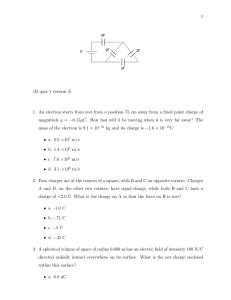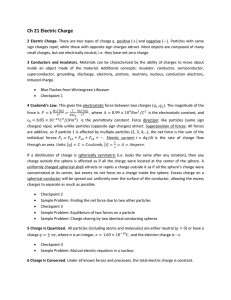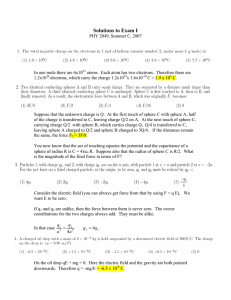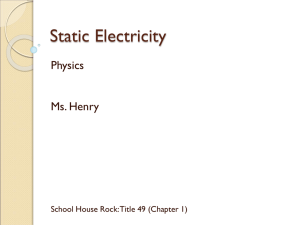Last updated: September 2, 2008
advertisement
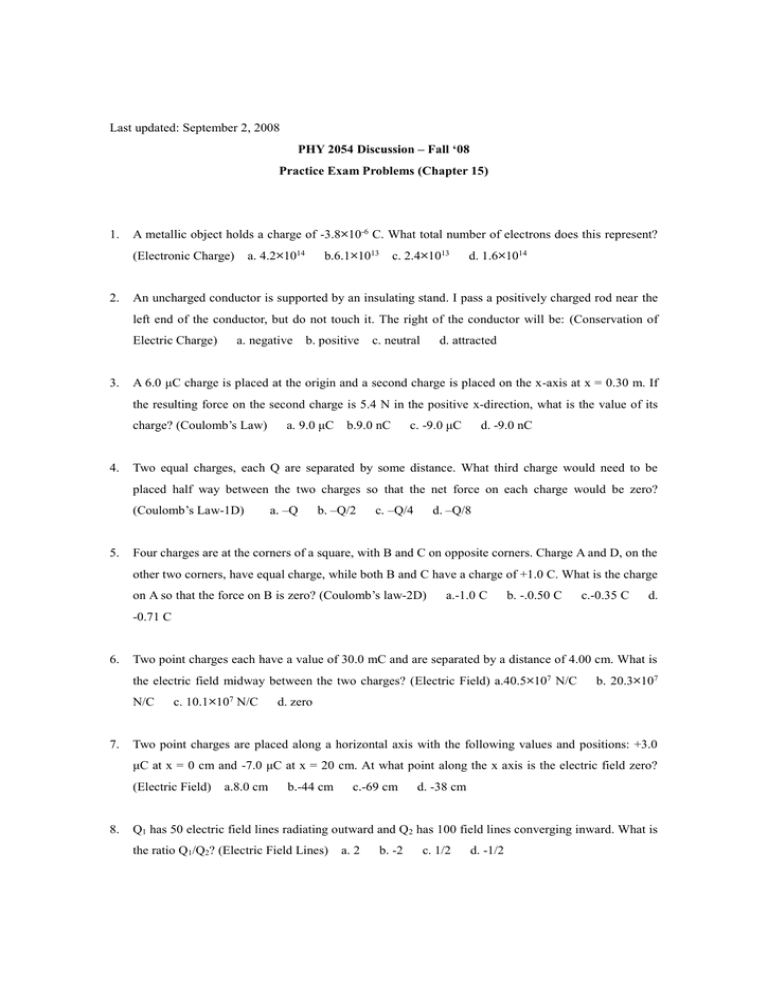
Last updated: September 2, 2008 PHY 2054 Discussion – Fall ‘08 Practice Exam Problems (Chapter 15) 1. A metallic object holds a charge of -3.8×10-6 C. What total number of electrons does this represent? a. 4.2×1014 (Electronic Charge) 2. b.6.1×1013 c. 2.4×1013 d. 1.6×1014 An uncharged conductor is supported by an insulating stand. I pass a positively charged rod near the left end of the conductor, but do not touch it. The right of the conductor will be: (Conservation of Electric Charge) 3. a. negative b. positive c. neutral d. attracted A 6.0 μC charge is placed at the origin and a second charge is placed on the x-axis at x = 0.30 m. If the resulting force on the second charge is 5.4 N in the positive x-direction, what is the value of its charge? (Coulomb’s Law) 4. a. 9.0 μC b.9.0 nC c. -9.0 μC d. -9.0 nC Two equal charges, each Q are separated by some distance. What third charge would need to be placed half way between the two charges so that the net force on each charge would be zero? (Coulomb’s Law-1D) 5. a. –Q b. –Q/2 c. –Q/4 d. –Q/8 Four charges are at the corners of a square, with B and C on opposite corners. Charge A and D, on the other two corners, have equal charge, while both B and C have a charge of +1.0 C. What is the charge on A so that the force on B is zero? (Coulomb’s law-2D) a.-1.0 C b. -.0.50 C c.-0.35 C d. -0.71 C 6. Two point charges each have a value of 30.0 mC and are separated by a distance of 4.00 cm. What is the electric field midway between the two charges? (Electric Field) a.40.5×107 N/C N/C 7. c. 10.1×107 N/C b. 20.3×107 d. zero Two point charges are placed along a horizontal axis with the following values and positions: +3.0 μC at x = 0 cm and -7.0 μC at x = 20 cm. At what point along the x axis is the electric field zero? (Electric Field) 8. a.8.0 cm b.-44 cm c.-69 cm d. -38 cm Q1 has 50 electric field lines radiating outward and Q2 has 100 field lines converging inward. What is the ratio Q1/Q2? (Electric Field Lines) a. 2 b. -2 c. 1/2 d. -1/2 9. The electric field associated with a uniformly charged hollow metallic sphere is the greatest at: (Conductors in Electrostatic Equilibrium) a. surface c. infinity the center of the sphere b. the sphere’s inner d. the sphere’s outer surface 10. The Millikan oil-drop experiment demonstrated that: (Millikan’s Experiment) fall slowly through the air a. small oil drops b. light beams can be used to illuminate small oil droplets electronic charge is quantized c. the d. falling oil droplets reach terminal speed 11. A charge Q accumulates on the hollow metallic dome, of radius R, of a Van de Graaff generator. A probe measures the electric field strength at various points outside the sphere surface. If the probe is initially at a distance 3R from the sphere’s center and then is moved to 4R, by what factor will the electric field reading change? (Van de Graaff Generator) a. (4/3)² b. 4/3 c. 3/4 d. (3/4)² 12. A spherical volume of space has an electric field of intensity 100 N/C directed radially outward from its surface of radius 0.600 m. What is the net charge enclosed within this surface? (Gauss’s Law) 6.8 nC b. 4.0 nC c. -6.8 nC a. d. -4.0 nC 13. A closed surface contains the following point charges: 6C, 4C, -2C, -4C. The electric flux coming out of the surface is: (Electric Flux) Answers: 1-c 2-b 3-a 4-c 5-c a. 16 C/ε0. 6-d 7-d 8-d b. -16 C/ε0. 9-d 10-c c. 4 C/ε0. 11-d 12-b d. -4 C/ε0. 13-c
